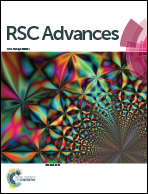Cathodic electrochemiluminescence behavior of an ammonolysis product of 3,4,9,10-perylenetetracarboxylic dianhydride in aqueous solution and its application for detecting dopamine†
Abstract
The cathodic electrochemiluminescence (ECL) behavior of the ammonolysis product of 3,4,9,10-perylenetetracarboxylic dianhydride (PTC–NH2) in aqueous solution with K2S2O8 as the co-reactant has been, for the first time reported, in this paper. The possible mechanisms have been investigated. Based on the fact that dopamine (DA) can efficiently quench the ECL intensity of PTC–NH2, DA was chosen as a template to investigate the application of PTC–NH2–S2O82− system in the sensor field. Under the optimal conditions, we achieved the detection of DA with the detection limit of 1.6 × 10−9 M. Due to the excellent ECL behavior, PTC–NH2 could be a new class of promising material for the construction of ECL sensors.


 Please wait while we load your content...
Please wait while we load your content...